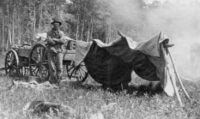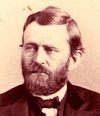Area History
 Way back in 1787, Wisconsin had its beginning as a part of the United States. On a basis of “sea to sea” grants given at the end of the Revolutionary War, the land between the Alleghany Mountains and the Mississippi River became the property of the thirteen colonies, the new United States. This area was designated as the Northwest Territory. It comprised what at present are the states of Ohio, Indiana, Michigan, Illinois and Wisconsin.
Way back in 1787, Wisconsin had its beginning as a part of the United States. On a basis of “sea to sea” grants given at the end of the Revolutionary War, the land between the Alleghany Mountains and the Mississippi River became the property of the thirteen colonies, the new United States. This area was designated as the Northwest Territory. It comprised what at present are the states of Ohio, Indiana, Michigan, Illinois and Wisconsin.
The Northwest Territory was then governed by officers appointed by Congress. When a given area could claim 60,000 residents, it could apply for statehood. In 1848, Wisconsin was given statehood, as all requirements were met. This was the last state created from the Northwest Territory.
In 1848, Wisconsin had only a few counties organized in the southern part of the state, but as more settlers moved in, additional counties were created in the northern part. In 1862, Congress passes the Homestead Law, which can be credited with the growth of the northern part of the state. Also the government made special concessions to the veterans of the Civil War, so our area was made especially attractive to people looking for new locations.
 In 1856, the State of Wisconsin created Burnett County from townships 38, 39 and 40 in ranges 12 to 20 of Polk County, and townships 41, 42 and 43 in ranges 12 to 16 of Douglas County. There followed nine more changes before 1883, at which time part of Burnett County was sectioned off for Washburn County, giving Burnett County pretty much the boundaries it has today.
In 1856, the State of Wisconsin created Burnett County from townships 38, 39 and 40 in ranges 12 to 20 of Polk County, and townships 41, 42 and 43 in ranges 12 to 16 of Douglas County. There followed nine more changes before 1883, at which time part of Burnett County was sectioned off for Washburn County, giving Burnett County pretty much the boundaries it has today.
Burnett County was named in honor of Thomas Pendleton Burnett (born c.1806), a very capable man who had opened a law office in Kentucky. He subsequently was appointed Indian sub-agent at Prairie du Chein. He was Member of Wisconsin territorial legislature, and is credited with efforts in behalf of Wisconsin Statehood. He and his wife died on the same day, depriving him of seeing his work completed.
From 1865 to 1875, Burnett County was all one township. That is, there was only one governing body appointed by Governor J. T. Lewis. He named Nimrod H. Hickerson, County Judge; Peter A. Anderson, Register of Deeds; Magnus Nelson, County Clerk; L. Thompson, County Treasurer; Canute Anderson, Clerk of Court; Jacob Larson, District Attorney; Martin B. Johnson, Sheriff; Michael Jensen, surveyor and Ole Aslakson, Superintendent of Schools.
 The county seat, selected by the state legislature, was Grantsburg, named after General Ulysses S. Grant. From 1865 to 1876, the county functions were carried out in the school house. The first county meeting was held on January 24, 1865. On November 7, 1865, the first election was held in Judge Hickerson’s home.
The county seat, selected by the state legislature, was Grantsburg, named after General Ulysses S. Grant. From 1865 to 1876, the county functions were carried out in the school house. The first county meeting was held on January 24, 1865. On November 7, 1865, the first election was held in Judge Hickerson’s home.
In 1876, a log cabin was built near Wood River, the first county office building. Later the offices were transferred to a building at the end of Main Street in Grantsburg. A courthouse costing $7,000 was constructed, but was destroyed by fire in 1887. In 1902, the stone and brick jail and sheriff’s residence were erected at a cost of $6,000.
The Township of Wood Lake was formed in 1875, followed by Trade Lake in 1876. Today there are twenty-one townships in the county.
The first census in 1860 listed twelve white settlers. By 1865 there were 171. Each succeeding census showed large increases in population: 1900 – 7,478; 1940 – 11,381; 1980 – 12,340; The first deed placed on record in Burnett County was a tax deed from Polk County to Simon Estensen, dated January 20, 1866.
Adapted from the “Burnett County Answer Book” by the Burnett County Unit of League of Women Voters of Wisconsin.
